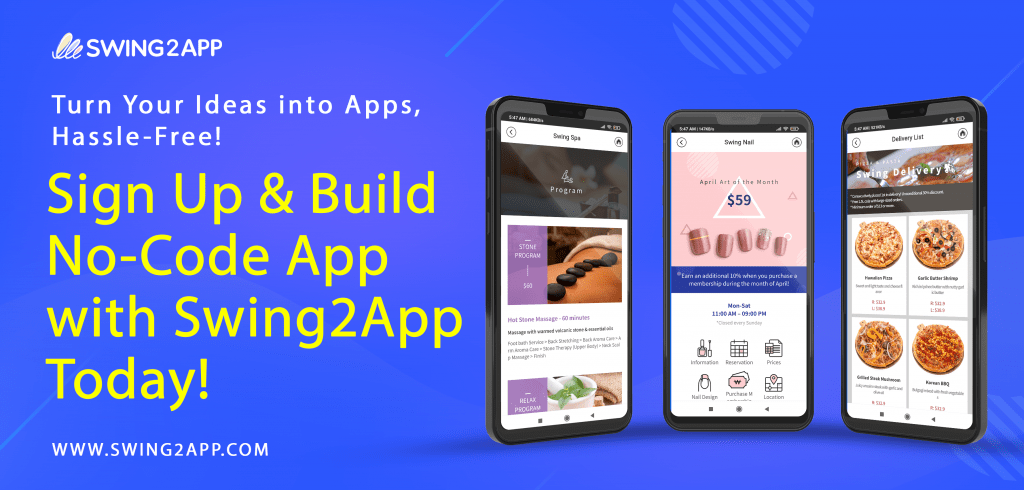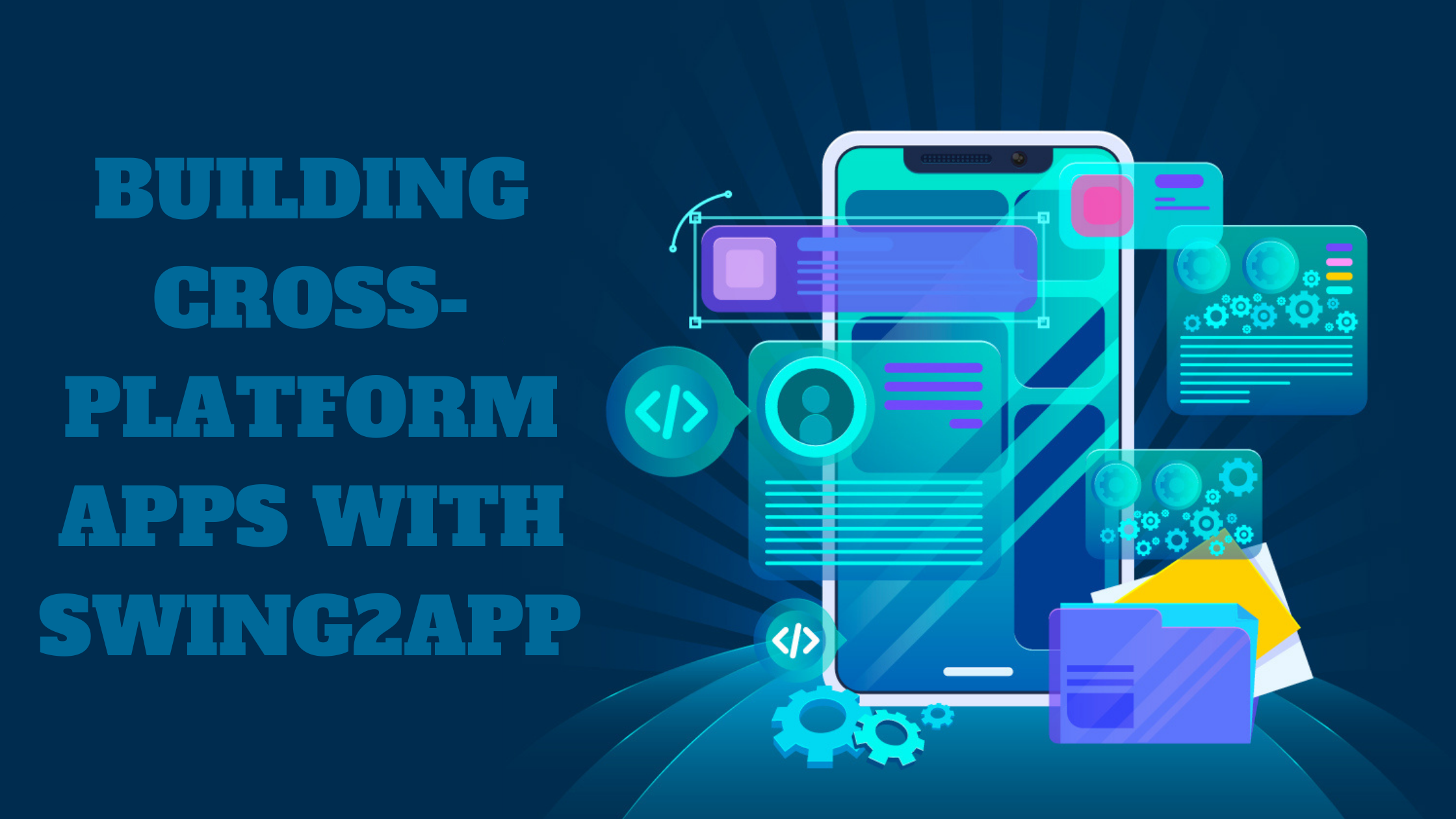Cross-platform apps are an ideal choice for app developers looking to develop an app for both iOS & Android platforms. However, software developers often face a dilemma: which is better – cross-platform or native applications?
With cross-platform applications, developers can reach a broader audience (both Android and iOS) with their products. On the other hand, native applications provide better performance and fewer crashes.
Luckily, Swing2App no-code app builder has both areas covered as our way of cross-platform app building is to create native-like apps for both: Android and iOS!
Swing2App no-code app builder users just have to build a single no-code app and then later choose on which platform they want to publish their app. This approach gives our users a relaxing app-building experience, where they don’t have to worry about the platform, as they can decide later if they want to publish on Android, iOS, or both platforms. Many businesses and app creators now understand the value of being present on both the App Store and Play Store simultaneously, all while managing costs efficiently.
Creating an app that works on multiple platforms online not only reaches a broader audience but also provides simplicity and cost-efficiency. Hence, opting for cross-platform mobile development is a smart choice.
Let’s understand everything about cross-platform apps.
WHAT ARE CROSS-PLATFORM APPS?
As mobile apps increasingly become vital for businesses, it’s crucial to grasp the complexities of app development. Cross-platform mobile development involves creating software apps compatible with multiple mobile operating systems.
In the context of cross-platform apps, developers have the option to share a portion or even the entirety of the source code. This allows developers to build and launch mobile resources that function on both Android and iOS without creating separate versions for each platform.
Why is cross-platform app development important in 2023?
Cross-platform mobile app development enables developers to create apps using a single codebase, thereby lowering development expenses. Additionally, it extends the reach of your app to a wider audience. This approach ensures a uniform user experience across various platforms, simplifying the process of maintenance and updates.
The mobile app industry offers over 4.4 million apps on Appstore and Google Play, installed on 6 billion smartphones worldwide, as of 2023. If you plan to develop an application, then cross-platform apps can give you access to both the Android & iOS app marketplaces.
THE DIFFERENCE BETWEEN NATIVE AND CROSS-PLATFORM APP DEVELOPMENT
The debate between Native and Cross-platform app development has been ongoing within the tech community for years. Some experts prefer native apps, while companies like Uber are venturing into cross-platform app development with their framework, Ribs, to revamp their driver app.
Both native and cross-platform development technologies continuously evolve. This dynamic nature suggests the need to revisit these topics periodically to assess which options currently excel. Native app development prioritizes creating a well-tailored design closely aligned with the target platform (such as Android or iOS), simplifying the process and avoiding the complexity of spanning multiple platform app development.
On the other hand, cross-platform frameworks aim to create apps that cater to a wide range of devices, reaching a broad audience during the programming and development phase.
| Parameter | Cross Platform Apps | Native Apps |
| Cost | Relatively low cost of development | High cost of development |
| Code Usability | Single code can be utilized for multiple platforms for easy portability | Works for only a single platform |
| Device Access | No assured access to all device APIs | SDK provides access to the device’s API without any issues |
| UI Consistency | Limited consistency | Consistent with the UI components of the device |
| Performance | High on performance but may lag and hardware compatibility issues may occur. | Seamless performance |
CHALLENGES IN THE CROSS-PLATFORM APP DEVELOPMENT PROCESS
A few years ago, cross-platform app development was primarily focused on creating simple mobile apps and games. However, as time has progressed, emerging technologies have made cross-platform development more adaptable, robust, and versatile.
1. Compatibility issues with different devices and platforms (iOS &Android)
When it comes to cross-platform mobile app development, compatibility can present challenges. Problems may arise when apps are not designed to run smoothly on certain devices, leading to performance issues.
2. Limited access to device hardware features
Cross-platform frameworks operate differently on multiple devices, making it challenging to utilize the unique features of each device. This limitation stems from the tools not having direct access to the hardware of these devices.
3. App Performance issues as compared to native apps
Performance issues can occur due to inconsistent communication between native and non-native components of devices, potentially affecting the user experience.
4. Challenge in keeping up with updates to different operating systems and devices
Cross-platform app developers often struggle to ensure that their apps remain compatible with evolving devices and operating systems.
Some other challenges faced by the cross-platform apps may include:
- Maintaining consistency across various devices and operating systems.
- Addressing performance-related issues to enhance the user experience.
- Security concerns, especially for business apps handling sensitive user data.
Despite these challenges, the advantages of cross-platform app development often outweigh the drawbacks, making it a valuable approach for many projects.
BENEFITS OF CROSS-PLATFORM MOBILE DEVELOPMENT
Cross-platform applications possess code that is shareable and can be employed across various platforms. This single codebase expedites the development process and results in cost savings, particularly when it comes to repetitive tasks like handling data serialization and making API calls. Quicker development generally leads to a more rapid time to market.
Embracing the cross-platform approach allows project managers to utilize their development resources more efficiently since there’s no need to allocate separate resources for creating apps for different platforms.
Additionally, a reduced volume of code reduces the likelihood of encountering bugs and security issues, thereby lessening the time and effort required for code testing and upkeep.
Another advantage is that, in many instances, developers only need proficiency in standard programming languages. Development tools and frameworks are readily available to handle the majority of the complex tasks.
Furthermore, cross-platform apps provide a broader reach as they can cater to the needs of diverse audiences using various operating systems and devices.
DRAWBACKS OF CROSS-PLATFORM MOBILE DEVELOPMENT
Performance problems represent the most prevalent concern encountered in cross-platform applications. A significant number of these applications offer restricted functionality due to their inability to accommodate numerous functions exclusive to native mobile devices, such as advanced graphics. The subpar design also contributes to this issue, leading to an unsatisfactory user experience.
Nevertheless, advancements in development technologies and frameworks are actively addressing these challenges, giving rise to cross-platform apps characterized by the following attributes:
- Flexible.
- Adaptable.
- Stable.
- exceptional performance
- Extensive functionality
- Capability to deliver a positive user experience (UX).
CROSS-PLATFORM APPS: A COST-EFFECTIVE SOLUTION FOR BUILDING MOBILE APPS MULTIPLE APP STORES
The mobile app landscape is primarily dominated by two major players: the Google Play Store and the Apple App Store. Companies cannot afford to overlook their presence on either of these platforms. However, developing code-based apps for each of them can be a costly endeavor.
Cross-platform apps offer a solution to this challenge. These apps follow the principle of “Write once, run everywhere,” allowing one app concept to function across different platforms. Their popularity has surged in recent years due to their user-friendliness, time-saving capabilities, and cost-effectiveness. Currently, approximately 33% of mobile developers utilize cross-platform technologies or frameworks, a number expected to continue its upward trajectory in the coming years.
In 2020, Android and iOS app revenue collectively reached a staggering $111 billion, nearly doubling the revenue from 2017. These impressive figures, among other factors, have spurred the creation of a total of 5.7 million apps available on the App Store and Play Store combined.
As these numbers continue to climb, developers seek swift and cost-effective methods for app development. Cross-platform development tools not only facilitate rapid app creation for multiple platforms but also offer a budget-friendly approach to the process.
NOTABLE CROSS-PLATFORM APPS
There are numerous instances of apps constructed utilizing cross-platform development tools. Currently, one-third of all developers opt for cross-platform solutions when building apps, and these figures are expected to increase as more companies prefer these apps over native alternatives. Here are a few noteworthy examples of cross-platform apps:
Gyroscope
This health and productivity company leveraged React Native, a JavaScript framework capable of constructing apps for both iOS and Android, to create their app. Utilizing React’s capabilities, they presented data in two visually appealing and well-designed formats.
Xianyu by Alibaba
Xianyu, a platform for second-hand goods under the Alibaba Group’s e-commerce umbrella, required a robust system for implementation and scalability. Therefore, they opted for Flutter, a framework developed by Google that enables the creation of applications for mobile, web, and desktop using a single codebase.
However, they have built these apps with the help of a highly skilled IT team that used the coding languages mentioned above. With Swing2App no-code app builder you don’t need to worry about coding at all, you can build cross-platform apps for Android, iOS, and web apps without any coding at all!
HOW TO BUILD A CROSS-PLATFORM APP WITH SWING2APP
Swing2App no-code app builder provides a speedy and budget-friendly answer to creating cross-platform applications. Instead of laboriously coding hundreds of lines for each platform, you can create a single app and deploy it across multiple platforms. What’s more, this can all be achieved effortlessly using the drag-and-drop functionality. In essence, developers can now construct apps without the need for manual coding. To create your own cross-platform app, whether it’s a Flutter app, an Android tablet app, or any other variety, simply follow these steps with Swing2App:
Signup Swing2App to create mobile apps
Swing2App no-code app builder offers a free sign-up option, allowing you to build your apps without any initial cost. You only pay when you’re ready to publish your app.
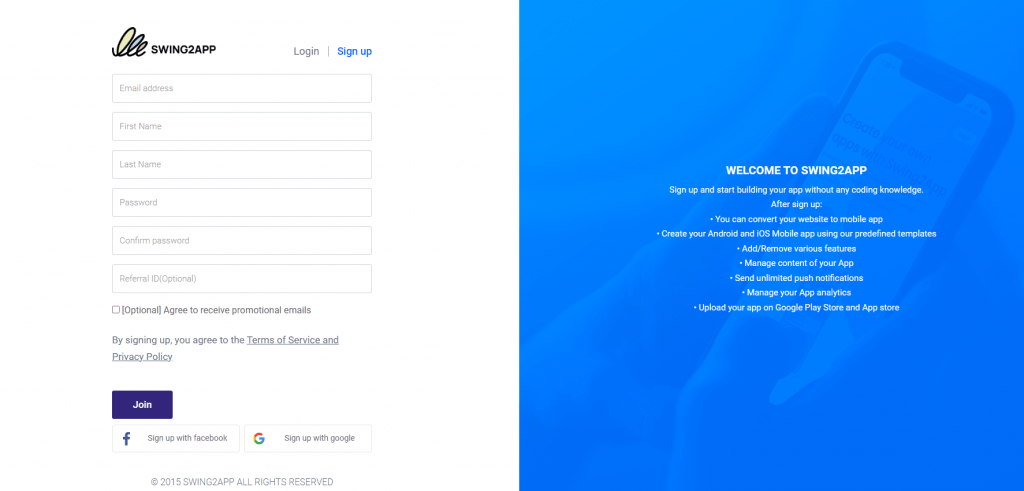
Click here to register for Swing2App no-code app builder.
Additionally, Swing2App no-code builder provides affordable subscription plans, ensuring that you can create and launch your apps within your budget.
Once you log in, you will be directed to the Maker V3 page of the Swing2App no-code builder.
Here click on the “+” icon in the top left of the bar to create a new app, here you will get a pop-up screen where you can choose which type of app you want to create. Here, we will go with the “fast app creation”.
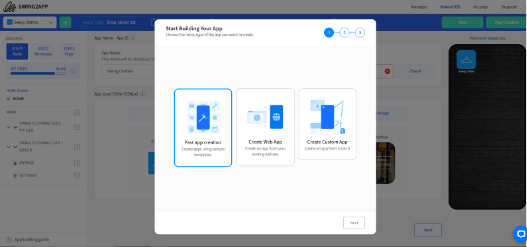
Fill out the basic details of your app.
This is the first step where you have to update your “App Basics” like your app name, app icon, and splash screen, and create a unique alphanumeric app ID. With this, your first step is completed.

Choose a template in the “prototype” section
Once you’re in your project, you’ll receive a guided tour of the Swing2App no-code builder, which you can choose to watch or skip. You can customize various features and styles, adding a personal touch by adjusting fonts and colors.
Next comes step 2 “Prototype”: you have to choose your app UI (prototype), Swing2App no-code app builder offers 5 variations as below:

Read more about the 5 Types of UI In Swing2app to Create a No-Code App
The Swing2App no-code app builder provides a variety of templates designed to simplify and expedite the app-building process. Select a template that suits your requirements and begin editing. Alternatively, you can initiate a new project from scratch by selecting the “Create Custom app” option in the beginning.

Upload content
Step 3 is “Page”, where you can customize your home page, add or delete menu options, add features and functionalities, and other advanced menu settings (like hiding a menu from a certain audience, etc.). To these menu options, if you have content such as images or audio files, you can easily upload them to the app using the Swing2App no-code builder. You’ll find user-friendly options and Swing2App Analytics support for creating engaging apps.
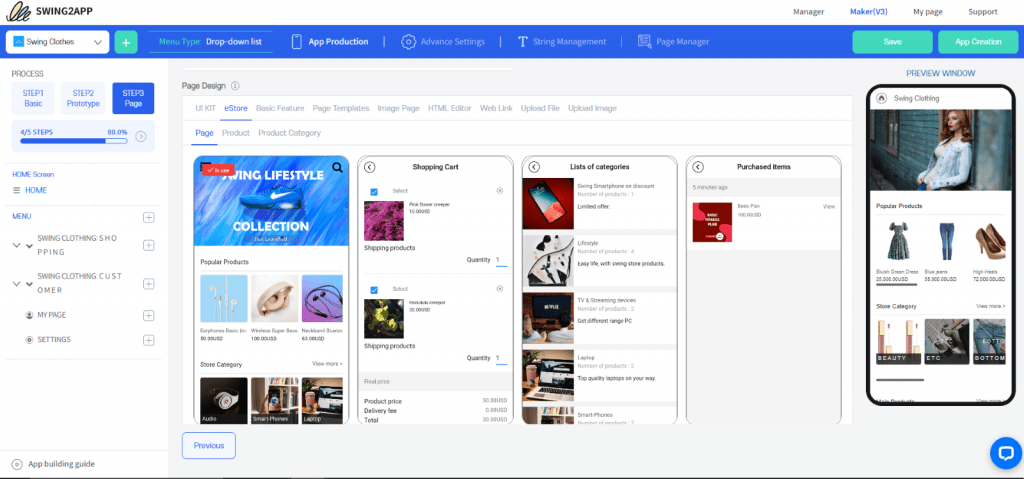
Monetize
Swing2App no-code builder also allows you to monetize your app by setting up Banner Ads, Interstitial Ads, and Native Ads, turning your app into a potential revenue stream. Moreover, Swing2App doesn’t charge any commission on ads , the entire ad revenue is 100% yours!
Also read: How to Make Money from Swing2App AdMob App Integration?
Upload to App Store
This single app can be submitted to both the App Store and Play Store Market, simplifying the distribution process across multiple app stores.

Additionally, Android users can download the app and test it on their device which helps you to determine if your app is user-friendly by yourself, but Apple users can’t. However, Apple users can get the app preview on Swing2App no-code app builder itself where they can even choose the device model which they want the check their app. You can preview your app by clicking on the “Preview window” on the top of the visual editor.
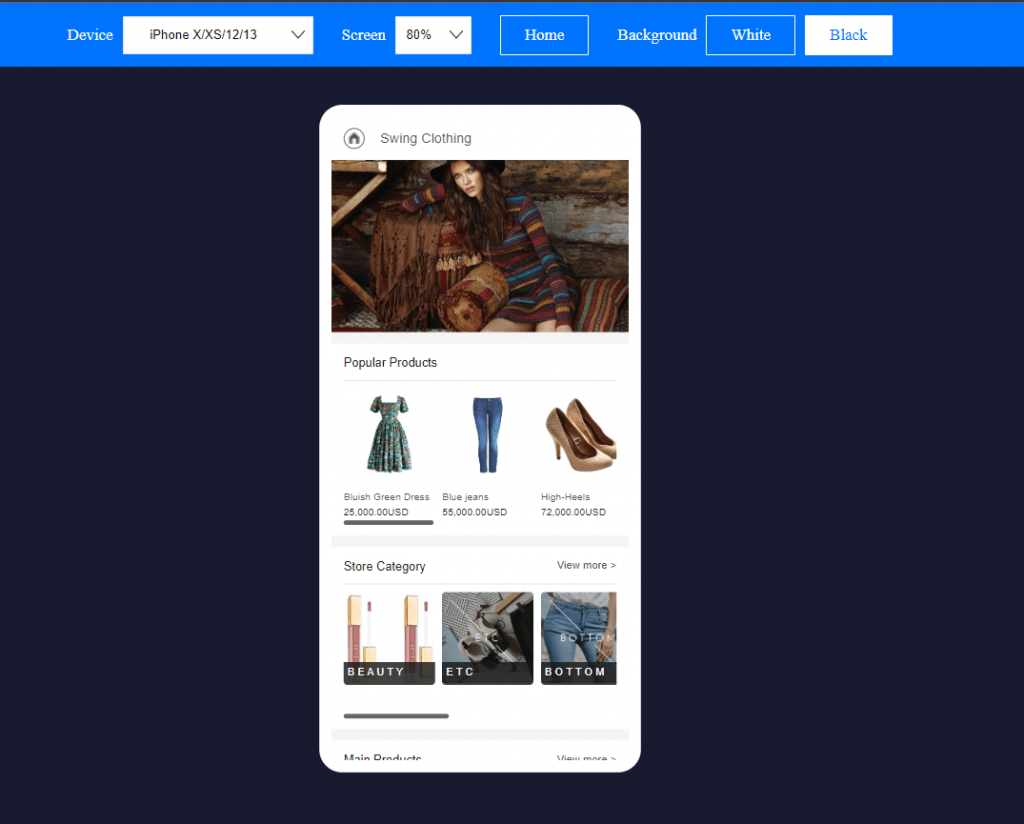
BENEFITS OF SWING2APP CROSS-PLATFORM BUILDER
Most multi-platform app builders still require some degree of coding skills. But Swing2App’s platform allows building cross-platform apps with no coding skills at all. Here are a few benefits of using Swing2App no-code builder:
Reach out to all mobile audience
Restricting your app to just one app store is no longer sufficient. By developing apps for major platforms like the Play Store and App Store, you can tap into a much larger target audience. With Swing2App no-code builder, you can effortlessly create iOS and Android apps, maximizing your exposure to a diverse audience.
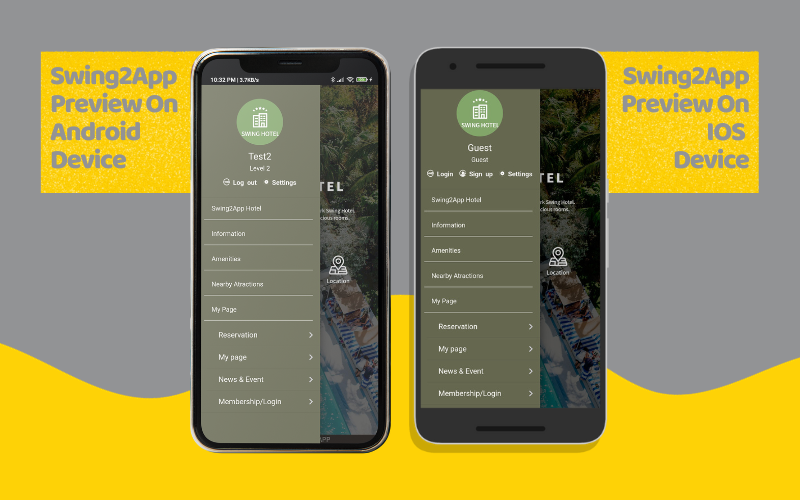
Easy to use
Which option sounds more appealing: writing hundreds of lines of code for each app from scratch, or utilizing a no-code builder to create a single app with no code that functions on multiple platforms? If the latter option sounds preferable, Swing2App no-code builder is the ideal solution!
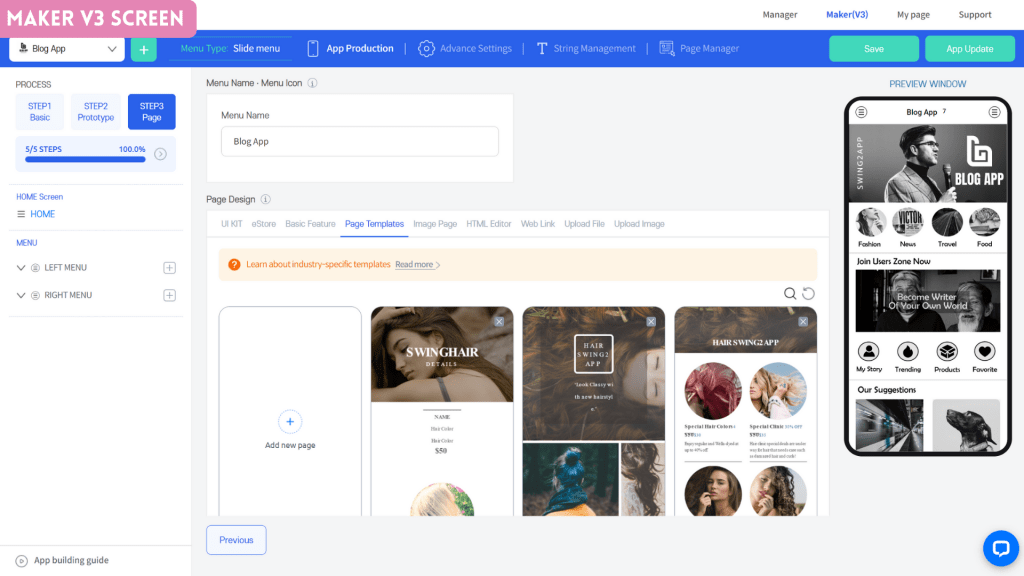
Easy to maintain
Managing a single app for all platforms is straightforward and allows for easy modifications. Moreover, updates can be swiftly synchronized across all platforms—a benefit that would be impractical with native apps.
Save money, Make Money
The concept of “Write once, run everywhere” has inspired multi-platform app creators. By eliminating the need to hire expert developers for each platform, companies can save a substantial amount of money. These cost savings can be channeled into investing in tools to facilitate business growth.
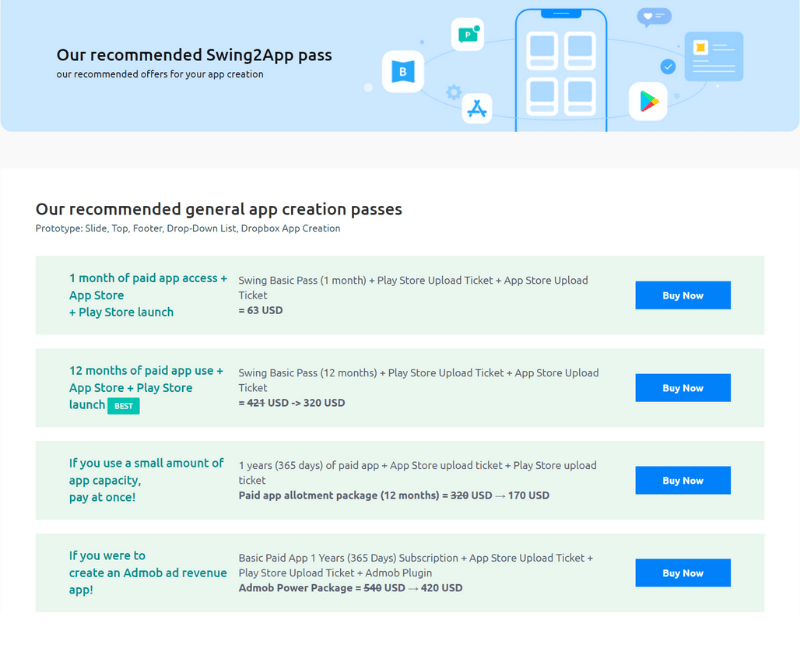
CREATE A CROSS-PLATFORM APP WITH SWING2APP!
With Swing2App no-code builder, developers can swiftly produce cross-platform apps in a matter of minutes. These apps are compatible with various platforms, resulting in cost savings compared to native apps. The remarkable part is that you can achieve all of this without the need for coding!
Furthermore, developers have the flexibility to incorporate various features such as Weblinks and Photo Galleries to enhance the interactivity of their apps. Additionally, advanced monetization techniques offer the potential for generating passive income.
Give Swing2App no-code builder a try and make cross-platform apps today!
